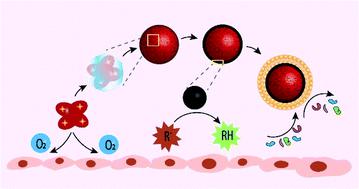当前位置:
X-MOL 学术
›
Biomater. Sci.
›
论文详情
Our official English website, www.x-mol.net, welcomes your feedback! (Note: you will need to create a separate account there.)
Metal–organic framework-based oxygen carriers with antioxidant protection as a result of a polydopamine coating
Biomaterials Science ( IF 6.6 ) Pub Date : 2021-09-06 , DOI: 10.1039/d1bm01005k Xiaoli Liu 1 , Michelle M T Jansman 1 , Wengang Li 2 , Paul Kempen 3 , Peter W Thulstrup 4 , Leticia Hosta-Rigau 1
Biomaterials Science ( IF 6.6 ) Pub Date : 2021-09-06 , DOI: 10.1039/d1bm01005k Xiaoli Liu 1 , Michelle M T Jansman 1 , Wengang Li 2 , Paul Kempen 3 , Peter W Thulstrup 4 , Leticia Hosta-Rigau 1
Affiliation

|
Rapid haemorrhage control to restore tissue oxygenation is essential in order to improve survival following traumatic injury. To this end, the current clinical standard relies on the timely administration of donor blood. However, limited availability and portability, special storage requirements, the need for blood type matching and risks of disease transmission result in severe logistical challenges, impeding the use of donor blood in pre-hospital scenarios. Therefore, great effort has been devoted to the development of haemoglobin (Hb)-based oxygen carriers (HBOCs), which could be used as a “bridge” to maintain tissue oxygenation until hospital admission. HBOCs hold the potential to diminish the deleterious effects of acute bleeding and associated mortality rates. We recently presented a novel HBOC, consisting of Hb-loaded metal organic framework (MOF)-based nanoparticles (NPs) (MOFHb-NPs), and demonstrated its ability to reversibly bind and release oxygen. However, a long standing challenge when developing HBOCs is that, over time, Hb oxidizes to non-functional methaemoglobin (metHb). Herein, we address this challenge by modifying the surface of the as-prepared MOFHb-NPs with an antioxidant polydopamine (PDA) coating. The conditions promoting the greatest PDA deposition are first optimized. Next, the ability of the resulting PDA-coated MOFHb-NPs to scavenge important reactive oxygen species is demonstrated both in a test tube and in the presence of two relevant cell lines (i.e., macrophages and endothelial cells). Importantly, this antioxidant protection translates into minimal metHb conversion.
中文翻译:

由于聚多巴胺涂层具有抗氧化保护的基于金属有机骨架的氧载体
快速控制出血以恢复组织氧合对于提高外伤后的存活率至关重要。为此,目前的临床标准依赖于及时给予献血者血液。然而,有限的可用性和便携性、特殊的储存要求、血型匹配的需要和疾病传播的风险导致了严重的后勤挑战,阻碍了在院前场景中使用供体血液。因此,人们致力于开发基于血红蛋白(Hb)的氧载体(HBOCs),它可以作为维持组织氧合直至入院的“桥梁”。HBOCs 具有减少急性出血和相关死亡率的有害影响的潜力。我们最近推出了一个新颖的 HBOC,Hb -NPs),并证明了其可逆结合和释放氧气的能力。然而,开发 HBOC 的一个长期挑战是,随着时间的推移,Hb 会氧化成非功能性高铁血红蛋白 (metHb)。在此,我们通过用抗氧化聚多巴胺 (PDA) 涂层修饰所制备的 MOF Hb -NPs的表面来解决这一挑战。首先优化促进最大 PDA 沉积的条件。接下来,在试管中和在两种相关细胞系(即巨噬细胞和内皮细胞)存在的情况下,证明了所得的 PDA 包被的 MOF Hb -NPs 清除重要活性氧的能力。重要的是,这种抗氧化保护转化为最小的甲基化血红蛋白转化。
更新日期:2021-10-06
中文翻译:

由于聚多巴胺涂层具有抗氧化保护的基于金属有机骨架的氧载体
快速控制出血以恢复组织氧合对于提高外伤后的存活率至关重要。为此,目前的临床标准依赖于及时给予献血者血液。然而,有限的可用性和便携性、特殊的储存要求、血型匹配的需要和疾病传播的风险导致了严重的后勤挑战,阻碍了在院前场景中使用供体血液。因此,人们致力于开发基于血红蛋白(Hb)的氧载体(HBOCs),它可以作为维持组织氧合直至入院的“桥梁”。HBOCs 具有减少急性出血和相关死亡率的有害影响的潜力。我们最近推出了一个新颖的 HBOC,Hb -NPs),并证明了其可逆结合和释放氧气的能力。然而,开发 HBOC 的一个长期挑战是,随着时间的推移,Hb 会氧化成非功能性高铁血红蛋白 (metHb)。在此,我们通过用抗氧化聚多巴胺 (PDA) 涂层修饰所制备的 MOF Hb -NPs的表面来解决这一挑战。首先优化促进最大 PDA 沉积的条件。接下来,在试管中和在两种相关细胞系(即巨噬细胞和内皮细胞)存在的情况下,证明了所得的 PDA 包被的 MOF Hb -NPs 清除重要活性氧的能力。重要的是,这种抗氧化保护转化为最小的甲基化血红蛋白转化。


























 京公网安备 11010802027423号
京公网安备 11010802027423号